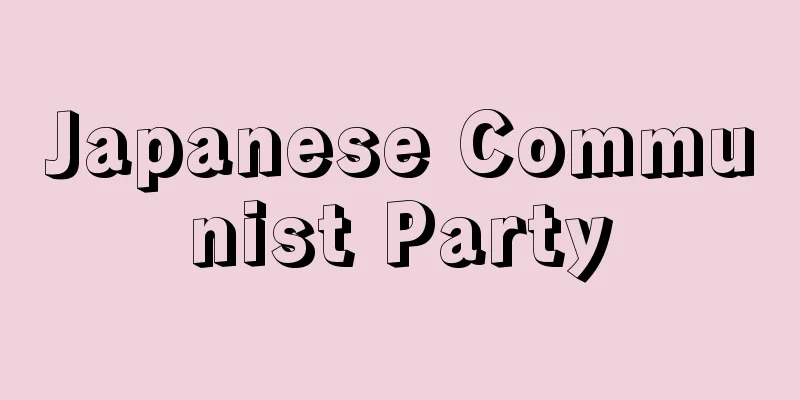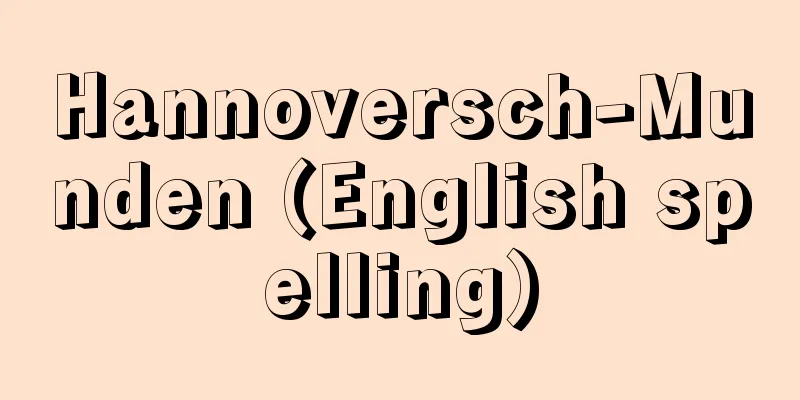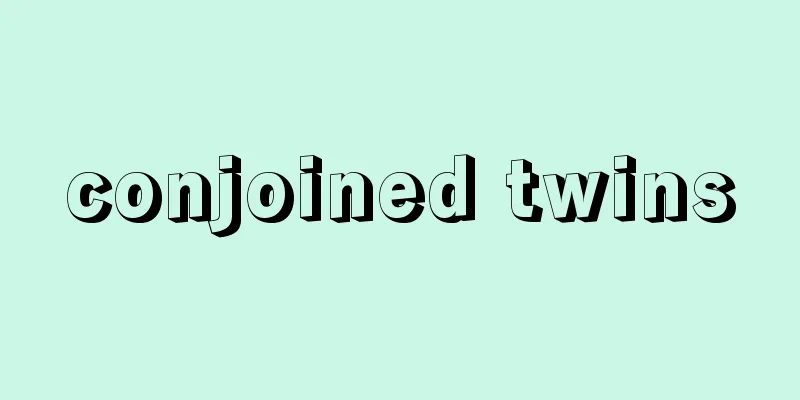Japanese Communist Party

|
A Japanese communist party. Founded in 1922 (Taisho 11), it is the Japanese political party that has existed the longest under the same party name both before and after World War II, and has the longest history. It was illegal for 23 years before World War II, and for half of that time, from 1935 (Showa 10) to 1945, the Central Committee was destroyed and organizational activities were suspended. It was only after Japan was defeated that the Communist Party openly appeared before the people and began legal activities. [Taguchi Fukuji] Communist Party before World War IIAccording to official party history, the founding convention of the Communist Party was held on July 15, 1922, in a private home in Datemachi, Shibuya. Its parent organization was the Japanese Communist Party Preparatory Committee, which had been formed in April of the previous year. The founding of the party was officially approved at the 4th Congress of Comintern, held at the end of 1922, and the "Comintern Japan Branch Japanese Communist Party" was established. Shaken by the first round of arrests in June 1923 (the First Communist Party Incident) and the subsequent massacres during the Great Kanto Earthquake in September, the party's senior officials resolved to dissolve the party in March of the following year, 1924. However, with guidance from Comintern, the party was reorganized at its third conference held in Goshiki Onsen, Yamagata Prefecture, in December 1926, and began publishing its illegal organ newspaper, Sekki, in February 1928. Shortly afterwards, the party suffered a major blow from successive crackdowns in the "March 15 Incident" on March 15, 1928, and the "April 16 Incident" on April 16, 1929. The period from 1931, when the Manchurian Incident began, to the mass arrests in October 1932 (Atami Incident) was the period when the Communist Party flourished most before the war. At its peak, it had about 500 party members and 7,000 copies of Akahata. However, after 1933, party leaders changed their positions one after another, the authorities strengthened their crackdown, and the party's espionage and provocation policies, as well as insufficient policies, caused factions within the party and the party's influence rapidly weakened. In March 1935, the last Central Committee member was arrested, and the party's Central Committee was finally destroyed. In July and August 1935, the policy of the anti-fascist People's Front decided at the 7th Congress of Comintern was conveyed to Japan by Nosaka Sanzo and others, and within Japan, Communist groups attempted to start a People's Front movement and rebuild the party, but they ultimately failed. Before World War II, the Communist Party carried out its activities based on programmatic guidelines such as the Draft Platform, the 1927 Theses, the 1932 Theses, and the Letter to Japanese Communists. These included demands for peace and democracy, such as the abolition of the Emperor System, universal suffrage for men and women over the age of 18, land liberation, the withdrawal of troops from Korea, Taiwan, and China, and opposition to wars of aggression. The party's basic strategy was a two-stage revolutionary line that would develop and transform a bourgeois democratic revolution into a socialist revolution. [Taguchi Fukuji] Communist Party after World War IIOn October 10, 1945, communists including Tokuda Kyuichi and Shiga Yoshio were released from prison by order of the occupying forces, and the Communist Party began to operate openly. The party was re-established at its 4th Party Congress in December of the same year, and demanded the full implementation of the Potsdam Declaration, the elimination of militarism, and thorough democratization. In the labor movement, which developed rapidly after the war, the party brought the Industrial Federation Conference under its leadership, and also demonstrated leadership in the Democratic People's Front movement, which gained momentum after Nosaka's return to Japan in 1946, expanding its influence among the masses. The party's power had grown to the point where 35 members were elected in the general election in January 1949. However, the party was divided and confused by foreign interference such as the Cominform commentary in January 1950, the expulsion and red purging of party officials by the occupying forces in June, confusion in the assessment of the situation and policies, and patriarchal and bureaucratic leadership, and Tokuda and the "mainstream" faction implemented ultra-left adventurist tactics such as military policies, so the party's strength declined significantly after 1950. At the 6th National Conference held in July 1955, the party abandoned armed struggle and restored unity. After the 7th Party Congress held in July-August 1958, the 8th Party Congress in July 1961 adopted a platform to achieve a socialist revolution through an anti-imperialist and anti-monopoly democratic revolution based on a united front, and Nosaka was elected Chairman of the Central Committee and Miyamoto Kenji was elected Secretary General. After the establishment of its platform, the Japanese Communist Party showed steady development until the mid-1970s. This can be attributed to efforts to establish an "independent line" as demonstrated in the Sino-Soviet debate and its attitude toward the Cultural Revolution, the advocacy of "people's parliamentarism" that positioned parliament and elections within the scope of political change, and above all, the success of building a modern party organization centered on the expansion of its party newspaper, Akahata, and the maintenance of strict party discipline. Thus, at the 11th Party Congress in July 1970, the party presented the idea of a reformist united front and a democratic coalition government, and at the 12th Party Congress in November 1973, the "Japanese Communist Party Proposal for a Democratic Coalition Government Platform" was adopted. As new situations developed from the late 1970s onwards, the party's strength remained stable or fluctuated in terms of the number of seats in the Diet, the number of votes, the vote ratio (around 10%), the number of party members, and the number of party newsletter readers, and in the 1980s, the party became increasingly isolated at the political level due to the clear "rightward shift" of centrist parties and the "realization" of the Socialist Party. However, in order to break the situation "against the second postwar reactionary offensive," the "National Council for Promoting Peace, Democracy, and Reform and Unity" was formed in May 1981, and in May 1986, at the party's initiative, the "Association for a Nuclear-Free Government" was also launched. In the 1990s, state socialism (a form of state rule in which the Communist Party was one party dictatorship in collusion with the state power) was dissolved one after another in the Soviet Union and Eastern Europe, and although Honorary Chairman Nosaka Sanzo was expelled, the JCP did not suffer a major blow. After the LDP's setback in the 1993 general election, a coalition government of eight non-LDP factions was formed, followed by a three-party coalition of the LDP, the Social Democratic Party, and Sakigake, under the Murayama and Hashimoto administrations. While the LDP regained its strength, the opposition parties continued to diversify and split. In the midst of this, the JCP promoted itself as the "only opposition party" and expanded its influence in national and local elections (especially in mayoral elections). It made a great advance in the July 1998 House of Councillors election, winning 23 seats and becoming the second largest opposition party. However, in the 2000s, the movement towards a two-party system centered on the Liberal Democratic Party and the Democratic Party has progressed, and the country has been struggling in various elections. In addition, relations with the Chinese Communist Party, which had been in a state of estrangement since the Japan-China talks in 1966, began to improve in 1998 through negotiations between then-Vice Chairman Hu Jintao and then-Chairman Fuwa Tetsuzo. As of 2006, the Communist Party currently has about 400,000 party members and 1.64 million subscribers to its newspaper. As of 2009, the party has 9 members in the House of Representatives, 7 members in the House of Councillors, and 3,050 local assembly members. In 1997, before the 21st Party Convention, former Chairman Miyamoto Kenji retired, and Fuwa Tetsuzo became Chairman of the Executive Committee and Shii Kazuo became Secretary General. At the 22nd Party Convention in 2000, Fuwa Tetsuzo became Chairman, Shii Kazuo became Chairman, and Ichida Tadayoshi became Secretary General. At the 24th Party Convention in 2006, Chairman Shii Kazuo and Secretary General Ichida Tadayoshi remained in their positions, while Fuwa Tetsuzo retired from his position as Chairman. At the 25th Party Convention in 2010, Shii and Ichida were reappointed. [Taguchi Fukuji] "Seventy Years of the Japanese Communist Party," written by the Central Committee of the Japanese Communist Party (1994, Shin Nihon Shuppansha), in three volumes ; "Eighty Years of the Japanese Communist Party, 1922-2002," edited and published by the Central Committee of the Japanese Communist Party (2003)" [References] | | | | |Source: Shogakukan Encyclopedia Nipponica About Encyclopedia Nipponica Information | Legend |
|
日本の共産主義政党。1922年(大正11)に結成され、日本の政党のなかでは、第二次世界大戦前・戦後を通じて同一の党名でもっとも長く存続し、もっとも古い歴史をもつ。第二次世界大戦前の23年間は非合法状態にあり、さらにその半分である1935年(昭和10)から1945年までの10年間は中央委員会が破壊され、組織的活動は中断された。共産党が国民の前に公然と姿を現し、合法的に活動を開始するのは、敗戦後のことである。 [田口富久治] 第二次世界大戦前の共産党共産党の創立大会は、公式党史上は、1922年7月15日、渋谷・伊達(だて)町の一民家で開かれたとされている。その母体は、前年4月結成の日本共産党準備会であった。党の創立は、1922年末に開かれたコミンテルン第4回大会で正式に承認され、「コミンテルン日本支部日本共産党」が成立した。 1923年6月の第一次検挙(第一次共産党事件)と引き続く9月の関東大震災での虐殺事件で動揺した共産党古参幹部は、翌1924年3月、解党を決議した。しかしコミンテルンの指導もあって、1926年12月、山形県五色(ごしき)温泉での第3回大会で党は再組織され、1928年2月からは非合法機関紙『赤旗(せっき)』も発刊された。その直後、1928年3月15日の「三・一五事件」、1929年4月16日の「四・一六事件」と相次いだ大弾圧によって、党は大きな打撃を被った。「満州事変」の始まった1931年から1932年10月の一斉検挙(熱海事件(あたみじけん))までが、戦前において共産党がもっとも発展した時期であり、最大時党員数約500名、『赤旗』7000部を記録した。しかし、1933年以降の党幹部の相次ぐ転向、当局の取締りの強化やスパイ・挑発政策、方針上の不十分さもあって党内に分派を生じ、党勢力は急速に弱体化していく。1935年3月、最後の中央委員の検挙によって、党中央委員会は最終的に壊滅した。1935年7~8月、コミンテルン第7回大会で決定された反ファシズム人民戦線の方針は野坂参三(さんぞう)らによって日本に伝えられ、国内でも、共産主義者グループによる人民戦線運動や党再建が試みられたが、結局成功するには至らなかった。 第二次世界大戦前の共産党は、綱領草案、「二七年テーゼ」、「三二年テーゼ」、「日本の共産主義者へのてがみ」などの綱領的指針に基づいて活動を進めた。これらのなかで、天皇制の廃止、18歳以上男女普通選挙権、土地解放、朝鮮・台湾・中国からの軍隊の撤退、侵略戦争反対などの平和と民主主義の要求が掲げられた。党の基本戦略は、ブルジョア民主主義革命から社会主義革命に発展転化する二段階革命路線であった。 [田口富久治] 第二次世界大戦後の共産党1945年(昭和20)10月10日、占領軍の指令で徳田球一、志賀義雄(よしお)らの共産主義者が出獄し、共産党は公然活動に乗り出した。同年12月の第4回党大会で再建された共産党は、ポツダム宣言の完全実施、軍国主義の一掃と民主化の徹底を要求した。戦後急速に発展した労働運動面では産別会議を指導下に置き、また1946年の野坂の帰国を機に盛り上がった民主人民戦線運動で指導性を発揮し、大衆的影響力を拡大した。1949年1月の総選挙では35名の当選を果たすまでに力を強めた。ところが、1950年1月のコミンフォルムの論評など外国からの干渉、6月の占領軍による党幹部の追放とレッド・パージ、さらに情勢評価と方針の混乱や家父長的・官僚的指導などによって党は分裂・混乱し、徳田ら「主流派」は軍事方針など極左冒険主義的戦術を実施したため、1950年以降党勢は著しく後退した。1955年7月に開かれた第6回全国協議会は、武装闘争を放棄し、党の統一を回復した。その後1958年7~8月の第7回党大会を経て、1961年7月の第8回党大会で、統一戦線に基づく反帝・反独占の民主主義革命を経て社会主義革命を達成するという綱領を採択し、中央委員会議長に野坂、書記長に宮本顕治(けんじ)を選出した。 綱領路線確定後の日本共産党は、1970年代中葉まで順調な発展を示した。これには、中ソ論争や文化大革命に対する態度などで示された「自主独立路線」確立の努力、議会と選挙を政治変革の展望のなかに位置づける「人民的議会主義」の提唱、そしてなかんずく機関紙『赤旗(あかはた)』の拡大を中心とする近代的政党組織づくりの成功と厳しい党規律の確保などが寄与したといえよう。こうして1970年7月の第11回党大会では革新統一戦線と民主連合政府の構想を提示し、1973年11月の第12回党大会では、「民主連合政府綱領についての日本共産党の提案」を採択した。 1970年代後半以降の新情勢の展開のなかで、党勢は、国会議席数、得票数、得票比率(10%前後)、党員数、機関紙読者数などで横ばいないしジグザグを示しており、また1980年代になって明確となった中道諸党の「右寄り」と社会党の「現実化」によって政界レベルでは孤立を深めた。しかし「戦後第二の反動攻勢に抗して」情勢を打開するため、1981年5月には「全国革新懇」(平和・民主主義・革新統一を進める全国懇談会)が結成され、1986年5月には党のイニシアティブで「非核の政府を求める会」も発足した。 1990年代に入って、ソ連・東欧などの国権社会主義(国家権力と癒着した共産党一党独裁の国家形態)の解体が相次ぎ、名誉議長野坂参三の除名はあったが、日本共産党はさほど大きな打撃を受けなかった。1993年(平成5)総選挙での自民党の後退のあと、非自民8派による連合政権、次に一転して自民・社会・さきがけの三党連立による村山政権、橋本政権へと続き、自民党が党勢を回復した反面、野党の多元化と分裂が続いた。そのなかで、日本共産党は「唯一の野党」を唱えて、全国選挙・地方選挙(とくに首長選挙)で党勢を拡大した。1998年7月の参院選では躍進し、23議席となって、野党第二党の地位を占めた。しかし、2000年代に入ると、自民党と民主党を軸とする二大政党制への動きが進展し、各種選挙において苦戦が続いている。なお、1966年の日中両党会談をきっかけに絶交状態にあった中国共産党とは、1998年、当時副主席であった胡錦濤(こきんとう/フーチンタオ)と委員長であった不破哲三(ふわてつぞう)らの交渉により関係改善へと向かった。 共産党の現勢は、2006年現在で、党員数約40万、機関紙読者数164万。2009年現在、国会議員数衆院9名、参院7名、地方議員数は3050人。1997年、第21回党大会を前に、前議長宮本顕治は引退し、幹部会委員長は不破哲三、書記局長は志位和夫(しいかずお)となり、2000年の第22回党大会で議長は不破哲三、委員長は志位和夫、書記局長は市田忠義(いちだただよし)となった。2006年の第24回党大会で委員長の志位和夫、書記局長の市田忠義は留任、不破哲三は議長職を退いた。2010年の第25回党大会で、志位、市田は再任された。 [田口富久治] 『日本共産党中央委員会著『日本共産党の七十年』全3冊(1994・新日本出版社)』▽『日本共産党中央委員会編・刊『日本共産党の八十年 1922~2002』(2003)』 [参照項目] | | | | |出典 小学館 日本大百科全書(ニッポニカ)日本大百科全書(ニッポニカ)について 情報 | 凡例 |
Recommend
Contini, G. (English spelling) ContiniG
...The exile also served as an opportunity to con...
Orbicular muscle of the eye
One of the facial muscles that surrounds the palpe...
Fida'i (English spelling)
An Arabic word meaning "one who sacrifices hi...
Hiroshi Makimura
1912-1938 A poet from the early Showa period. Bor...
Kyansittha (English spelling)
1040‐1113 The third king of the Pagan dynasty in M...
Canadian Abyssal Plain
…The names of the landforms and the depths of the...
Kana writing - Kanagaki
... As the number of people using kanji increased...
Eremocitrus
…The genus Citropsis , which is thought to be the...
Cross-bedding
...It is also called cross-lamination. This is a ...
Ouhoku Line - Ouhokusen
...The main stops are Yonezawa, Yamagata, Akita, ...
Night monkey - Night monkey
New World monkeys of the Capuchin family of primat...
Indirect democracy
A political system or method of government admini...
Art Pepper - Art Pepper
→ Pepper Source: Shogakukan Encyclopedia Nipponic...
Aitne (English spelling)
Jupiter's 31st moon. Discovered in 2001. Named...
Ukintaku - Ukintaku
... According to the people of the Song Dynasty, ...









